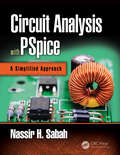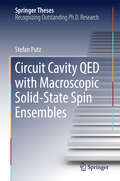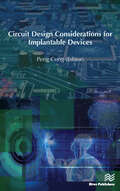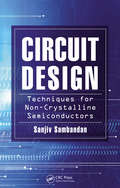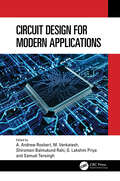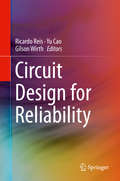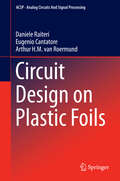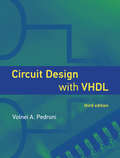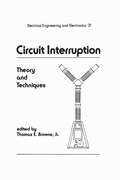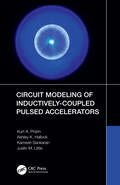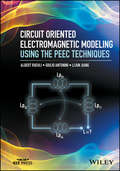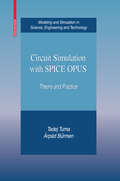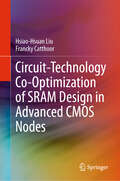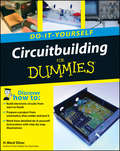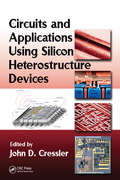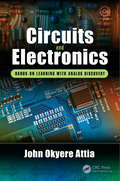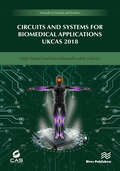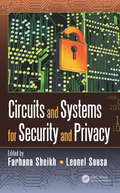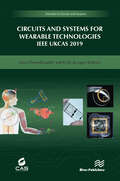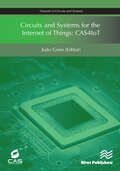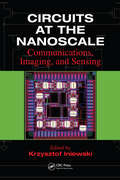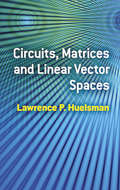- Table View
- List View
Circuit Analysis with PSpice: A Simplified Approach
by Nassir H. SabahElectric circuits, and their electronic circuit extensions, are found in all electrical and electronic equipment; including: household equipment, lighting, heating, air conditioning, control systems in both homes and commercial buildings, computers, consumer electronics, and means of transportation, such as cars, buses, trains, ships, and airplanes. Electric circuit analysis is essential for designing all these systems. Electric circuit analysis is a foundation for all hardware courses taken by students in electrical engineering and allied fields, such as electronics, computer hardware, communications and control systems, and electric power. This book is intended to help students master basic electric circuit analysis, as an essential component of their professional education. Furthermore, the objective of this book is to approach circuit analysis by developing a sound understanding of fundamentals and a problem-solving methodology that encourages critical thinking.
Circuit Cavity QED with Macroscopic Solid-State Spin Ensembles (Springer Theses)
by Stefan PutzThis thesis combines quantum electrical engineering with electron spin resonance, with an emphasis on unraveling emerging collective spin phenomena. The presented experiments, with first demonstrations of the cavity protection effect, spectral hole burning and bistability in microwave photonics, cover new ground in the field of hybrid quantum systems. The thesis starts at a basic level, explaining the nature of collective effects in great detail. It develops the concept of Dicke states spin-by-spin, and introduces it to circuit quantum electrodynamics (QED), applying it to a strongly coupled hybrid quantum system studied in a broad regime of several different scenarios. It also provides experimental demonstrations including strong coupling, Rabi oscillations, nonlinear dynamics, the cavity protection effect, spectral hole burning, amplitude bistability and spin echo spectroscopy.
Circuit Design Considerations for Implantable Devices
by Peng CongImplantable devices are a unique area for circuit designers. A comprehensive understanding of design trade-offs at the system level is important to ensure device success. Circuit Design Considerations for Implantable Devices provides knowledge to CMOS circuit designers with limited biomedical background to understand design challenges and trade-offs for implantable devices, especially neural interfacing.Technical topics discussed in the book include: Neural interface Neural sensing amplifiers Electrical stimulation Embedded Signal Analysis Wireless Power Transmission to mm-Sized Free-Floating Distributed Implants Next Generation Neural Interface Electronics
Circuit Design Techniques for Non-Crystalline Semiconductors
by Sanjiv SambandanDespite significant progress in materials and fabrication technologies related to non-crystalline semiconductors, fundamental drawbacks continue to limit real-world application of these devices in electronic circuits. To help readers deal with problems such as low mobility and intrinsic time variant behavior, Circuit Design Techniques for Non-Cryst
Circuit Design for Modern Applications
by A. Andrew Roobert, M. Venkatesh, Shiromani Balmukund Rahi, G. Lakshmi Priya and Samuel TensinghThis book offers a clear exploration of cutting-edge semiconductor circuit technologies and their practical applications. It covers topics like advanced transistor design, low-power consumption techniques, and high-performance circuit design.Circuit Design for Modern Applications explores the recent innovations in semiconductor technology. Bandgap reference circuits, quad model transistors, voltagecontrolled oscillators, LDO regulators, power amplifiers, low noise amplifiers, operational amplifiers, low-power CNTFET-based quaternary multipliers, and STT MRAM-based cache memory for multicore systems are discussed. It points out the difficulties in designing CMOS analog and RF circuits for mmWave applications and looks into newly developed field-effect transistors for an alternate solution. Innovative devices such as III-V material-based HEMTs, and junctionless FETs are discussed. The book also looks at creative ways to improve circuit performance and energy efficiency, which is a useful resource for academics, researchers, and industry experts working in semiconductors.This book will help the readers to stay on the cutting edge of contemporary circuit design technologies, covering various topics from fundamental circuit design to high-performance circuits.
Circuit Design for Reliability
by Yu Cao Gilson Wirth Ricardo ReisThis book presents physical understanding, modeling and simulation, on-chip characterization, layout solutions, and design techniques that are effective to enhance the reliability of various circuit units. The authors provide readers with techniques for state of the art and future technologies, ranging from technology modeling, fault detection and analysis, circuit hardening, and reliability management.
Circuit Design on Plastic Foils (Analog Circuits and Signal Processing #133)
by Eugenio Cantatore Arthur H.M. Roermund Daniele RaiteriThis book illustrates a variety of circuit designs on plastic foils and provides all the information needed to undertake successful designs in large-area electronics. The authors demonstrate architectural, circuit, layout, and device solutions and explain the reasons and the creative process behind each. Readers will learn how to keep under control large-area technologies and achieve robust, reliable circuit designs that can face the challenges imposed by low-cost low-temperature high-throughput manufacturing.
Circuit Design with VHDL
by Volnei A. PedroniThis textbook teaches VHDL using system examples combined with programmable logic and supported by laboratory exercises. While other textbooks concentrate only on language features, Circuit Design with VHDL offers a fully integrated presentation of VHDL and design concepts by including a large number of complete design examples, illustrative circuit diagrams, a review of fundamental design concepts, fully explained solutions, and simulation results. The text presents the information concisely yet completely, discussing in detail all indispensable features of the VHDL synthesis. The book is organized in a clear progression, with the first part covering the circuit level, treating foundations of VHDL and fundamental coding, and the second part covering the system level (units that might be located in a library for code sharing, reuse, and partitioning), expanding upon the earlier chapters to discuss system coding.
Circuit Design with VHDL, third edition (The\mit Press Ser.)
by Volnei A. PedroniA completely updated and expanded comprehensive treatment of VHDL and its applications to the design and simulation of real, industry-standard circuits.This comprehensive treatment of VHDL and its applications to the design and simulation of real, industry-standard circuits has been completely updated and expanded for the third edition. New features include all VHDL-2008 constructs, an extensive review of digital circuits, RTL analysis, and an unequaled collection of VHDL examples and exercises. The book focuses on the use of VHDL rather than solely on the language, with an emphasis on design examples and laboratory exercises.The third edition begins with a detailed review of digital circuits (combinatorial, sequential, state machines, and FPGAs), thus providing a self-contained single reference for the teaching of digital circuit design with VHDL. In its coverage of VHDL-2008, it makes a clear distinction between VHDL for synthesis and VHDL for simulation. The text offers complete VHDL codes in examples as well as simulation results and comments. The significantly expanded examples and exercises include many not previously published, with multiple physical demonstrations meant to inspire and motivate students. The book is suitable for undergraduate and graduate students in VHDL and digital circuit design, and can be used as a professional reference for VHDL practitioners. It can also serve as a text for digital VLSI in-house or academic courses.
Circuit Design: Anticipate, Analyze, Exploit Variations
by Stephan Weber Candido DuarteCircuit Design = Science + Art! Designers need a skilled "gut feeling" about circuits and related analytical techniques, plus creativity, to solve all problems and to adhere to the specifications, the written and the unwritten ones. You must anticipate a large number of influences, like temperature effects, supply voltages changes, offset voltages, layout parasitics, and numerous kinds of technology variations to end up with a circuit that works. This is challenging for analog, custom-digital, mixed-signal or RF circuits, and often researching new design methods in relevant journals, conference proceedings and design tools unfortunately gives the impression that just a "wild bunch" of "advanced techniques" exist. On the other hand, state-of-the-art tools nowadays indeed offer a good cockpit to steer the design flow, which include clever statistical methods and optimization techniques.Actually, this almost presents a second breakthrough, like the introduction of circuit simulators 40 years ago! Users can now conveniently analyse all the problems (discover, quantify, verify), and even exploit them, for example for optimization purposes. Most designers are caught up on everyday problems, so we fit that "wild bunch" into a systematic approach for variation-aware design, a designer's field guide and more. That is where this book can help! Circuit Design: Anticipate, Analyze, Exploit Variations starts with best-practise manual methods and links them tightly to up-to-date automation algorithms. We provide many tractable examples and explain key techniques you have to know. We then enable you to select and setup suitable methods for each design task - knowing their prerequisites, advantages and, as too often overlooked, their limitations as well. The good thing with computers is that you yourself can often verify amazing things with little effort, and you can use software not only to your direct advantage in solving a specific problem, but also for becoming a better skilled, more experienced engineer. Unfortunately, EDA design environments are not good at all to learn about advanced numerics. So with this book we also provide two apps for learning about statistic and optimization directly with circuit-related examples, and in real-time so without the long simulation times. This helps to develop a healthy statistical gut feeling for circuit design. The book is written for engineers, students in engineering and CAD / methodology experts. Readers should have some background in standard design techniques like entering a design in a schematic capture and simulating it, and also know about major technology aspects.
Circuit Interruption: Theory and Techniques
by Thomas E. Browne Jnr.Here-in one current, comprehensive source-is a wealth of both theoretical and practicalinformation on circuit interruption. Twenty-two authorities at the leading edge of researchand development provide a solid grasp of circuit breaker design and performance... and that's knowledge you can put to work immediately!arcuit Interruption surpasses other books in completeness and currency-includingcoverage of the sulfur hexafluoride puffer, the vacuum breaker, and the low-voltagemolded-case breakers, that are taking the place of many older types. In addition to thelatest theories and techniques, this major volume examines promising future trends.More than 400 clear illustrations help make the text easy to follow, and over 620 keyreferences point the way to the best places for continuing study.Today, the field of circuit interruption is so diverse that a thorough single source reallystands out. arcuit Interruption is that- source, the perfect reference for electrical, electronic,power, and design engineers; and researchers investigating circuit breaker design,interaction of breakers and power circuits, power transmission, power distribution,circuit interruption, electric contacts, and gaseous conduction. Moreover, this exceptionalbook serves as an excellent source for practicing power engineers as well as an invaluablesupplement to graduate-level engineering courses in circuit interruption, transmission,and distribution of power . . . and a supplement in professional seminars and society/association courses.
Circuit Modeling of Inductively-Coupled Pulsed Accelerators
by Kurt A. Polzin Ashley K. Hallock Kamesh Sankaran Justin M. LittleThis monograph describes lumped-element modelling techniques for inductively-coupled pulsed accelerators, starting from the basic physical description of the various processes and then bringing all the pieces together into solutions. Coilguns, inductive pulsed plasma thrusters, and compact toroids have each been individually studied using the methods used in this monograph. This monograph is of interest to researchers and graduate students in physics, engineering, and mathematics presently studying inductively-coupled pulsed accelerators.Features The first book to unify the lumped-element modelling techniques for various inductively-coupled pulsed accelerator implementations. Discussion of modelling different accelerators in a coherent, rigorous manner, demonstrating the similarities and differences for each type. Authored by authorities in the field.
Circuit Oriented Electromagnetic Modeling Using the PEEC Techniques
by Albert Ruehli Giulio Antonini Lijun JiangBridges the gap between electromagnetics and circuits by addressing electrometric modeling (EM) using the Partial Element Equivalent Circuit (PEEC) method This book provides intuitive solutions to electromagnetic problems by using the Partial Element Equivalent Circuit (PEEC) method. This book begins with an introduction to circuit analysis techniques, laws, and frequency and time domain analyses. The authors also treat Maxwell's equations, capacitance computations, and inductance computations through the lens of the PEEC method. Next, readers learn to build PEEC models in various forms: equivalent circuit models, non-orthogonal PEEC models, skin-effect models, PEEC models for dielectrics, incident and radiate field models, and scattering PEEC models. The book concludes by considering issues like stability and passivity, and includes five appendices some with formulas for partial elements. Leads readers to the solution of a multitude of practical problems in the areas of signal and power integrity and electromagnetic interference Contains fundamentals, applications, and examples of the PEEC method Includes detailed mathematical derivations Circuit Oriented Electromagnetic Modeling Using the PEEC Techniques is a reference for students, researchers, and developers who work on the physical layer modeling of IC interconnects and Packaging, PCBs, and high speed links.
Circuit Simulation Methods and Algorithms (Electronic Engineering Systems #4)
by Jan OgrodzkiCircuit Simulation Methods and Algorithms provides a step-by-step theoretical consideration of methods, techniques, and algorithms in an easy-to-understand format. Many illustrations explain more difficult problems and present instructive circuits. The book works on three levels:The simulator-user level for practitioners and students who want to better understand circuit simulators. The basic theoretical level, with examples, dedicated to students and beginning researchers. The thorough level for deep insight into circuit simulation based on computer experiments using PSPICE and OPTIMA. Only basic mathematical knowledge, such as matrix algebra, derivatives, and integrals, is presumed.
Circuit Simulation with SPICE OPUS: Theory and Practice (Modeling and Simulation in Science, Engineering and Technology)
by Tadej Tuma Árpád BuermenThis book is a unique combination of a basic guide to general analog circuit simulation and a SPICE OPUS software manual, which may be used as a textbook or self-study reference. The book is divided into three parts: mathematical theory of circuit analysis, a crash course on SPICE OPUS, and a complete SPICE OPUS reference guide. All simulations as well as the free simulator software may be directly downloaded from the SPICE OPUS homepage: www.spiceopus.si. Circuit Simulation with SPICE OPUS is intended for a wide audience of undergraduate and graduate students, researchers, and practitioners in electrical and systems engineering, circuit design, and simulation development.
Circuit-Technology Co-Optimization of SRAM Design in Advanced CMOS Nodes
by Francky Catthoor Hsiao-Hsuan LiuModern computing engines—CPUs, GPUs, and NPUs—require extensive SRAM for cache designs, driven by the increasing demand for higher density, performance, and energy efficiency. This book delves into two primary areas within ultra-scaled technology nodes: (1) advancing SRAM bitcell scaling and (2) exploring innovative subarray designs to enhance power-performance-area (PPA) metrics across technology nodes. The first part of the book utilizes a bottom-up design-technology co-optimization (DTCO) approach, employing a dedicated PPA simulation framework to evaluate and identify the most promising strategies for SRAM bitcell scaling. It offers a comprehensive examination of SRAM bitcell scaling beyond 1 nm node, outlining a structured research cycle that includes identifying scaling bottlenecks, developing cutting-edge architectures with complementary field-effect transistor (CFET) technology, and addressing challenges such as process integration and routing complexities. Additionally, this book introduces a novel write margin methodology to better address the risks of write failures in resistance-dominated nodes. This methodology accounts for time-dependent parasitic bitline effects and incorporates timing setup of write-assist techniques to prevent underestimating the yield loss. In the second part, the focus shifts to a top-down DTCO approach due to the diminishing returns of bitcell scaling beyond 5 Å node at the macro level. As technology scales, increasing resistance and capacitance (RC) lead designers to adopt smaller subarray sizes to reduce effective RC and enhance subarray-level PPA. However, this approach can result in increased inter-subarray interconnect overhead, potentially offsetting macro-level improvements. This book examines the effects of various subarray sizes on macro-level PPA and finds that larger subarrays can significantly reduce interconnect overhead and improve the energy-delay-area product (EDAP) of SRAM macro. The introduction of the active interconnect (AIC) concept enables the use of larger subarray sizes, while integrating carbon nanotube FET as back-end-of-line compatible devices results in macro-level EDAP improvements of up to 65% when transitioning from standard subarrays to AIC divided subarrays. These findings highlight the future trajectory of SRAM subarray design in deeply scaled nodes.
Circuitbuilding Do-It-Yourself For Dummies
by H. Ward SilverDO-IT-YOURSELFHere's the fun and easy way to start building circuits for your projectsHave you ever wanted to build your own electronic device? Put together a thermostat or an in-line fuse, or repair a microphone cable? This is the book for you! Inside you'll find the tools and techniques you need to build circuits, with illustrated, step-by-step directions to help accomplish tasks and complete projects.As you accomplish the tasks throughout the book, you'll construct many projects while learning the key circuitbuilding principles and techniques. Find out about measuring and testing, maintenance and troubleshooting, cables, connectors, how to test your stuff, and more.Stuff You Need to Know*The tools you need and how to use them*How to make sense of schematics and printed circuit boards*Basic techniques for creating any circuit*How to make and repair cables and connectors*Testing and maintenance procedures
Circuits and Applications Using Silicon Heterostructure Devices
by John D. CresslerNo matter how you slice it, semiconductor devices power the communications revolution. Skeptical? Imagine for a moment that you could flip a switch and instantly remove all the integrated circuits from planet Earth. A moment’s reflection would convince you that there is not a single field of human endeavor that would not come to a grinding halt, be it commerce, agriculture, education, medicine, or entertainment. Life, as we have come to expect it, would simply cease to exist. Drawn from the comprehensive and well-reviewed Silicon Heterostructure Handbook, this volume covers SiGe circuit applications in the real world. Edited by John D. Cressler, with contributions from leading experts in the field, this book presents a broad overview of the merits of SiGe for emerging communications systems. Coverage spans new techniques for improved LNA design, RF to millimeter-wave IC design, SiGe MMICs, SiGe Millimeter-Wave ICs, and wireless building blocks using SiGe HBTs. The book provides a glimpse into the future, as envisioned by industry leaders.
Circuits and Electronics: Hands-on Learning with Analog Discovery
by John Okyere AttiaThe book provides instructions on building circuits on breadboards, connecting the Analog Discovery wires to the circuit under test, and making electrical measurements. Various measurement techniques are described and used in this book, including: impedance measurements, complex power measurements, frequency response measurements, power spectrum measurements, current versus voltage characteristic measurements of diodes, bipolar junction transistors, and Mosfets. The book includes end-of-chapter problems for additional exercises geared towards hands-on learning, experimentation, comparisons between measured results and those obtained from theoretical calculations.
Circuits and Systems for Biomedical Applications: UKCAS 218
by Hadi Heidari; Sara GhoreishizadehCircuits and Systems for Biomedical Applications-UKCAS 2018 covers several advanced topics in the area of Devices, Analog and Mixed-Signal Circuits and Systems for Biomedical Applications. The fundamental aspects of these topics are discussed, and state-of-the-art developments are presented. The book proceeds the 1st United Kingdom Circuits and Systems (UKCAS 2018) Workshop. It addresses multidisciplinary theme areas such as Biosensing, Memristors, next-generation medical diagnostics, neural-inspired circuits, neural implants, neuro-prostheses, prosthetic hand and neuro-rehabilitation. Having perceived the device and circuit assets for such technologies and knowing what challenges these present for the biomedical scientists and engineers, integrated circuits for addressable biosensing are reviewed in the first chapter. The Second Chapter is harnessing the power of the brain using metaloxide Memristors. The third chapter contains construction of an endoscopic capsule for the diagnostics of dysmotilities in the gastrointestinal track. The next three chapters are on neural interfaces: analogue building blocks of neural inspired circuits are described in the fourth chapter while chapter five focuses on circuits for bio-potential recording from the brain. Networked Integrated circuits and their use in creating advanced implantable stimulation systems will be discussed in chapter six. This topic will be completed by circuits and systems for control of Prosthetic Hands in seventh chapter and genetically enhanced brainimplants for neuro-rehabilitation in chapter eight.
Circuits and Systems for Security and Privacy (Devices, Circuits, and Systems)
by Farhana Sheikh Leonel SousaCircuits and Systems for Security and Privacy begins by introducing the basic theoretical concepts and arithmetic used in algorithms for security and cryptography, and by reviewing the fundamental building blocks of cryptographic systems. It then analyzes the advantages and disadvantages of real-world implementations that not only optimize power, area, and throughput but also resist side-channel attacks. Merging the perspectives of experts from industry and academia, the book provides valuable insight and necessary background for the design of security-aware circuits and systems as well as efficient accelerators used in security applications.
Circuits and Systems for Wearable Technologies: IEEE UKCAS 219
by Sara Ghoreishizadeh Kylie De JagerThis book is based on presentations given at the 2nd IEEE United Kingdom Circuits and Systems (UKCAS 2019) Workshop. It covers several advanced topics in the areas of semiconductor devices, circuits and systems, and energy harvesting; discussing their application in emerging implantable and wearable technologies and IoT. Notable application examples discussed include rapid infectious disease monitoring, in-situ tear fluid analysis, sleep engineering, chronic pain treatment, personalised anti-cancer therapy, foetus and neonate monitoring, monitoring of bone healing, orthopedic implants, magnetomyography and intelligent gesture recognition. Fundamental aspects of these topics are discussed, and state-of-the-art developments are presented.
Circuits and Systems for the Internet of Things: CAS4IoT
by João GoesInternet-of-Things (IoT) can be envisaged as a dynamic network of interconnected physical and virtual entities (things), with their own identities and attributes, seamlessly integrated in order to e.g. actively participate in economic or societal processes, interact with services, and react autonomously to events while sensing the environment. By enabling things to connect and becoming recognizable, while providing them with intelligence, informed and context based decisions are expected in a broad range of domains spanning from health and elderly care to energy efficiency, either providing business competitive advantages to companies, either addressing key social concerns. The level of connectivity and analytical intelligence provided by the IoT paradigm is expected to allow creating new services that would not be feasible by other means. This CAS4IoT book targets post-graduate students and design engineers, with the skills to understand and design a broader range of analog, digital and mixed-signal circuits and systems, in the field of IoT, spanning from data converters for sensor interfaces to radios, ensuring a good balance between academia and industry, combined with a judicious selection of worldwide distinguished authors.
Circuits at the Nanoscale: Communications, Imaging, and Sensing (Devices, Circuits, and Systems)
by Krzysztof IniewskiCircuits for Emerging Technologies Beyond CMOS New exciting opportunities are abounding in the field of body area networks, wireless communications, data networking, and optical imaging. In response to these developments, top-notch international experts in industry and academia present Circuits at the Nanoscale: Communications, Imaging, and Sensing. This volume, unique in both its scope and its focus, addresses the state-of-the-art in integrated circuit design in the context of emerging systems. A must for anyone serious about circuit design for future technologies, this book discusses emerging materials that can take system performance beyond standard CMOS. These include Silicon on Insulator (SOI), Silicon Germanium (SiGe), and Indium Phosphide (InP). Three-dimensional CMOS integration and co-integration with Microelectromechanical (MEMS) technology and radiation sensors are described as well. Topics in the book are divided into comprehensive sections on emerging design techniques, mixed-signal CMOS circuits, circuits for communications, and circuits for imaging and sensing. Dr. Krzysztof Iniewski is a director at CMOS Emerging Technologies, Inc., a consulting company in Vancouver, British Columbia. His current research interests are in VLSI ciruits for medical applications. He has published over 100 research papers in international journals and conferences, and he holds 18 international patents granted in the United States, Canada, France, Germany, and Japan. In this volume, he has assembled the contributions of over 60 world-reknown experts who are at the top of their field in the world of circuit design, advancing the bank of knowledge for all who work in this exciting and burgeoning area.
Circuits, Matrices and Linear Vector Spaces (Dover Books on Electrical Engineering)
by Lawrence P. HuelsmanThis high-level undergraduate text explains the mathematics behind basic circuit theory. Its self-contained treatment covers matrix algebra, which provides a general means of formulating the details of a linear system. In addition, the author presents the basic theory of n-dimensional spaces and demonstrates its application to linear systems. A development of the mathematics of matrix algebra and determinants is followed by the application of matrix techniques to a general discussion of circuits. Subsequent topics include the properties of active and passive two-port devices, the basic theory of linear vector spaces, and the natural frequencies of a network. Appendixes cover the indefinite-transfer matrix, gyrators with complex gyration admittance, and network transformations. A wealth of equations and calculation problems appear throughout the text.
